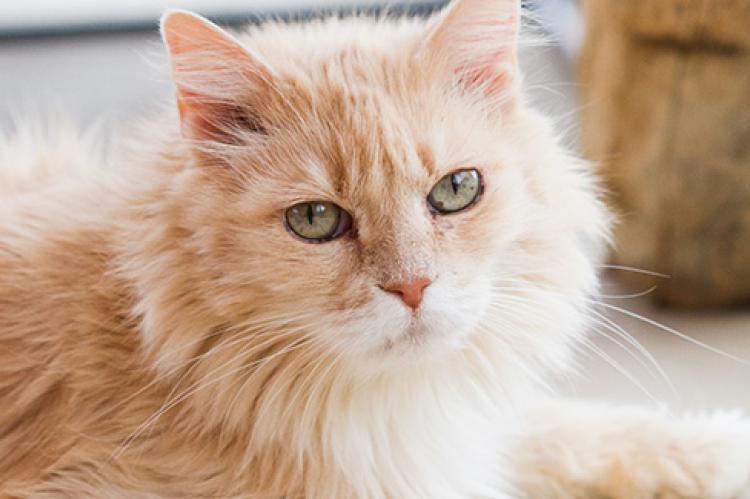Kidney Disease in Cats: Causes, Signs, and Treatment

Chronic kidney disease is one of the most common diseases in older cats. However, it can occur at any age. There are multiple causes of kidney disease in cats. And one of the very frustrating things is that often by the time it is identified, the cause itself is no longer present and is no longer treatable. Plus, by the time there are obvious abnormalities in kidney blood values, which is a common mode of kidney disease detection, you have marked kidney disease.
The best method of early detection of feline kidney disease is a urinalysis. But usually animals with early renal disease are not showing any signs of illness — or if they are, the signs are minimal. So unless it’s part of a routine wellness check, the disease is often missed.
Learn more about the causes, signs, and potential treatments of kidney disease in cats.
Signs of kidney disease in cats
The kidney has numerous critical functions. It filters around 20% of the body’s blood, regulates body water and electrolyte balance, and helps regulate arterial pressure and acid base balance. It also regulates the excretion of calcium and the production of the active form of vitamin D. And it plays a key role in the metabolism of some important body minerals and produces almost all of a special substance called erythropoietin, which stimulates the production of red blood cells in the bone marrow.
In addition to all this, the kidney is responsible for getting rid of metabolic waste products and chemicals through excretion in the urine. If this vital organ is not functioning as it should, there are lots of systemic consequences.
The most common signs of kidney disease in cats are increased thirst and urination. In later stages of the disease, gastrointestinal signs such as bad breath, vomiting, poor appetite, and diarrhea may appear. There also might be a gradual decline in body condition with weight loss and poor fur quality.
However, some cats show no signs of kidney disease at all, and their disease is picked up during routine physical examination and screening tests of blood and urine.
Causes of feline kidney disease
Several medical problems can cause kidney disease in cats. The most common cause is the resulting damage from toxins, infectious diseases, and diseases that impair kidney blood flow.
Common toxins to be aware of are ethylene glycol (antifreeze), lily flowers, other plants, and vitamin D. Cholecalciferol (vitamin D) is a common ingredient in rodent poison, vitamin supplements, and even psoriasis creams. When consumed, it is metabolized by the body into calcitriol, which changes renal absorption and resorption of calcium. The result is extremely high blood calcium and phosphorous levels that severely damage the kidneys. If animals are exposed to vitamin D, treatment needs to be prompt to ensure a good prognosis.
A common infectious disease that can ultimately cause renal disease in cats is pyelonephritis. This infection usually spreads to the kidney from a lower urinary tract infection. It’s important to visit your vet as soon as possible should you suspect your animal has come in contact with, or been afflicted by, any of the above.
Treatment and prognosis
Kidney disease in cats is typically irreversible. Animals with kidney disease can be stable for long periods with good treatment, but ultimately the disease will progress.
Treatment for feline kidney disease has multiple goals, one of which is keeping the cat hydrated. Some good strategies to increase water intake in cats are feeding wet food and providing a water fountain or leaving a dripping faucet. Some cats like flavored water; you can try low-sodium chicken/beef broth or tuna juice. Some animals also will tolerate subcutaneous fluids (fluids given under the skin).
Plus, there are also special prescription diets formulated for animals with kidney disease that have demonstrated some clinical benefit. And studies have shown benefit from supplementation with essential fatty acids.
Veterinarians pay attention to blood electrolytes in kidney disease patients. Some animals need special drugs to bind phosphorus, and some need potassium supplementation. Depending on the degree of kidney disease, some animals leak protein into their urine and require medication to help with this. Often, our kidney patients develop high blood pressure and anemia. Animals with kidney disease need ongoing regular visits with their veterinarians to fine-tune and individualize therapy.
The good news is that there are some exciting newer treatment options for kidney disease. In cats, renal transplant has worked quite successfully, and continuous renal replacement therapy has been used in universities and teaching hospitals. In a form of dialysis, the patient's blood is passed through filtration tubing into a machine where waste products and water are removed. From there, the patient's blood is taken into the continuous renal replacement therapy unit. The uremic toxins are removed, and the electrolytes are normalized. Then, the blood is returned to the patient.
Although cats with kidney disease will eventually succumb to their disease, they can live longer and happier lives with new treatment options.